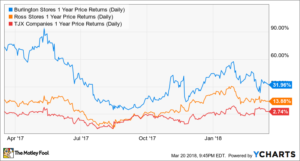One of the big narratives in investing today is the rise of e-commerce’s disruption of traditional brick-and-mortar retail. According to a recent analysis by Business Insider, over 6,400 retail stores closed in 2017, with another 3,600 closings projected for this year.
And yet, there are a handful of retailers that have not only been surviving the e-commerce disruption, but actually thriving. Here are three — Burlington Stores (NYSE: BURL), Dollar General (NYSE: DG), and Best Buy (NYSE: BBY) — that have bucked the e-commerce onslaught, and the secrets to their success.

Burlington Stores
Growing up, I remember the TV commercials for Burlington Coat Factory, which is now Burlington Stores. The former coat and winter-wear specialist has transformed itself into a full-assortment off-price retailer, and over the past 12 months, its stock has surged nearly 35%, compared with the S&P’s 14.3%.
Burlington is riding the off-price wave in retail, a trend that emerged in the wake of the 2008 recession, and the value-conscious approach to apparel shopping has persisted even though the economy has recovered since then.
Off-price retailers typically purchase closeout branded merchandise from retailers that hasn’t sold at full price. Then the goods are sold for a big markdown in off-price stores. In addition, off-price retailers have a fun “treasure hunt” atmosphere about them, another lure to go to their physical stores. Over the past few years, these discount retailers have taken away share from middle-income, mall-based department stores such as Macy’s (NYSE: M).
Burlington has outperformed even its off-price peers, like TJX Companies (NYSE: TJX) and Ross Stores (NASDAQ: ROST). The company has made a big effort to diversify from its core winter wear, becoming a more comprehensive “all weather” retailer like these rivals. Furthermore, Burlington has a smaller footprint at only 629 stores, compared with 4,070 for TJX and 1,622 for Ross, so Burlington could have more growth ahead of it as the company increases its store count.

Dollar General
Sticking with the off-price theme, Dollar General has capitalized on a similar trend, operating roughly 14,500 dollar stores across the country, with many of them in rural and suburban neighborhoods within a few miles of its customers. Dollar General offers cleaning products, refrigerated and packaged food, household products, apparel, automotive products, and seasonal items. It does so at rock-bottom prices, due to its low-cost operating model, small-store format, and fast in-and-out layout.
The small-store format and convenient locations differentiate dollar stores from big-box discounters like Walmart (NYSE: WMT) and Costco (NASDAQ: COST), and they also cater to a population that may live far from city centers and don’t want to lay out the extra cash for an Amazon (NASDAQ: AMZN) Prime subscription.
Capitalizing on this profitable niche, Dollar General grew sales approximately 8.8% on the back of 2.7% same-store sales growth for the full year 2017, and its stock is up 35% over the last 12 months.
Best Buy
In addition to the rise of off-price, another dominant theme over the past decade has been the increasing importance of smartphones, laptops, and the connected home. Of course, not everyone is a technical expert, and many shoppers may find the task of selecting these important, big-ticket items a bit intimidating.
Best Buy, under the leadership of CEO Hubert Joly, has done a great job of filling the needs in this niche. Reacting to the threat of Amazon’s rising electronics business, Best Buy embarked on a well-executed transition around price-matching, consolidating the store base into a showcase-and-ship footprint, and improving the in-store experience with branded kiosks to lure top retailers. The company also benefited from bankruptcies of rivals HH Gregg, Circuit City, and Radio Shack, becoming the leading brick-and-mortar electronics specialist.
Today, Best Buy is rolling out new services under its Best Buy 2020 strategy, which will include high-touch services such as Total Tech Support for households for $19.99 per month (or $199 for the year), as well as free in-home consultations to design home systems.
Providing specialized service on high-dollar, somewhat complicated products has set Best Buy apart in an e-commerce world. Last quarter, Best Buy delivered a huge 9% comparable-store sales increase (and that was adjusted for an extra week), accelerating over the beginning of the year, and smashing analyst expectations of 3%. Its stock is up 58% in the past 12 months.
Well-executed niche strategies
Burlington’s low-priced treasure hunts, Dollar General’s small-store convenience and value, and Best Buy’s niche expertise have allowed these companies to weather the e-commerce storm. Each company also has top-notch management that was able to execute on discrete plans to amplify each company’s strengths, and their shareholders are now reaping the benefits.


